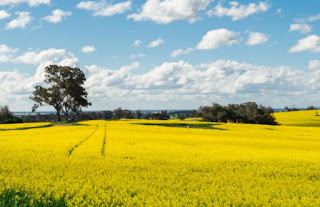For National Science Week 2021 we are celebrating Food – Different by Design. We count on having a variety of foods available in our local markets, but is it local food? In this post, we will look at Australian agricultural production and how the industry has embraced new technologies.
Where do we produce food?
Agriculture is a BIG deal in
Australia, accounting for 55% of land use and 25% of water extraction. According
to the Australian Bureau of Statistics, grazing occurs on 325 million hectares and cropping
on 31 million hectares. Forestry plantations occupy 700 000 hectares. Although
officially agricultural land, another 19 million hectares is not used for
production and 41% of this land is set aside for conservation. The diagram
below shows the locations of different types of agriculture.
How much food does Australia
produce?
Australian farmers produce much
more food than we need – enough food for 60 – 70 million people! As a result,
71% of our agricultural production is exported. Although Australian production
meets our nutritional needs, we import 11% of our food and beverages. Imports
are mainly processed food such as frozen and canned vegetables, with some out
of season fresh produce.
How do advances in technology
affect food production?
Technology allows a few people to farm very large areas efficiently. Operators with large farms can afford efficient technology such as self-driving machinery, irrigation systems that measure soil moisture, and colour sensors that target weeds with herbicide. You can see examples of the cutting edge technology used to grow Australian cotton in Google Arts & Culture.
In addition to advances in
machinery, there are three main genetically modified (GM) crops in Australia. GM cotton resists insect pests and
tolerates herbicides. There are two types of GM canola, one is resistant to
herbicides and the other produces healthy Omega-3 oils. Safflower has also been
genetically modified to produce more oleic acid in the seeds. Safflower oil is
used for industrial oils and animal feed.
Explore
- Get an overview of agriculture in Australia from ABARES.
- Do you think the future of farming may be in space? Try designing an International Space Farm with our PALMS STEM project.
- Learn about soils (the basis for agricultural production) in our blog.
- Investigate the role of humus and rock in plant growth and compare soils from different parent rocks.




